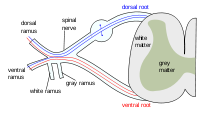
Photo from wikipedia
Progenitors of the developing human neocortex reside in the ventricular and outer subventricular zones (VZ and OSVZ, respectively). However, whether cells derived from these niches have similar developmental fates is… Click to show full abstract
Progenitors of the developing human neocortex reside in the ventricular and outer subventricular zones (VZ and OSVZ, respectively). However, whether cells derived from these niches have similar developmental fates is unknown. By performing fate mapping in primary human tissue, we demonstrate that astrocytes derived from these niches populate anatomically distinct layers. Cortical plate astrocytes emerge from VZ progenitors and proliferate locally, while putative white matter astrocytes are morphologically heterogeneous and emerge from both VZ and OSVZ progenitors. Furthermore, via single-cell sequencing of morphologically defined astrocyte subtypes using Patch-seq, we identify molecular distinctions between VZ-derived cortical plate astrocytes and OSVZ-derived white matter astrocytes that persist into adulthood. Together, our study highlights a complex role for cell lineage in the diversification of human neocortical astrocytes. Description Origin of astrocyte populations In the developing brain, radial glia are the stem cells that generate astrocytes. By midgestation in humans, radial glia form two populations derived from the pial surface of the brain or the ventricular surface. Allen et al. used lineage tracing and single-cell transcriptomics in the developing human brain to understand how these two populations of radial glia relate to astrocyte diversity. Astrocytes that populate the brain’s gray matter, which is densely packed with neuronal cell bodies, are generated by stem cells in the ventricular zone. Stem cells in the outer subventricular zone produce a different suite of astrocytes restricted to the brain’s white matter. —PJH During human brain development, different populations of radial glial cells produce diverse types of neurons and astrocytes.
Journal Title: Science
Year Published: 2022
Link to full text (if available)
Share on Social Media: Sign Up to like & get
recommendations!